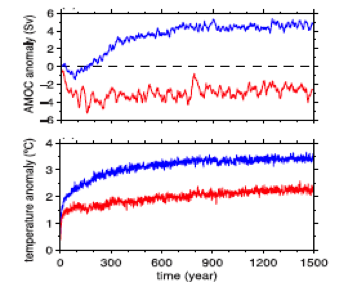Different AMOC responses to global warming under modern and glacial conditions
Researchers investigated the response of Atlantic Meridional Overturning Circulation (AMOC) to the rise of atmospheric CO2 in the NCAR Climate System Model version 3, with the focus on the different responses under modern and glacial periods. The AMOC response to the sudden doubling of CO2 differs significantly between the modern and the glacial conditions. The AMOC is eventually reduced in the modern climate, but intensified in the glacial condition (see Figure). The response of the AMOC under both climates has a similar initial stage (~100 years) that is characterized by a rapid weakening and a similar final stage that is characterized by a slow strengthening longer than 1000 years. The initial weakening is mainly driven by the anomalous surface heat flux in the subpolar North Atlantic, as suggested by previous studies, while the final slow strengthening could be attributed to the reduction of brine rejection in the Southern Ocean and the subsequent weakening of Antarctic Bottom Water. However, at glacial climate, the AMOC experiences an intermediate stage – with a rapid intensification period of ~300 years – and a large overshoot response. This overshoot is caused predominantly by the reduction of the meltwater in the northern North Atlantic associated with the retreat of the large amount of sea ice, an effect that becomes dominant when the subpolar North Atlantic is covered by sea ice as in the glacial condition.

AMOC Response to global warming: Dependence on the background climate and response timescale (Climate Dynamics)
1University Wisconsin-Madison
2National Center for Atmospheric Research
Topics
- AMOC
